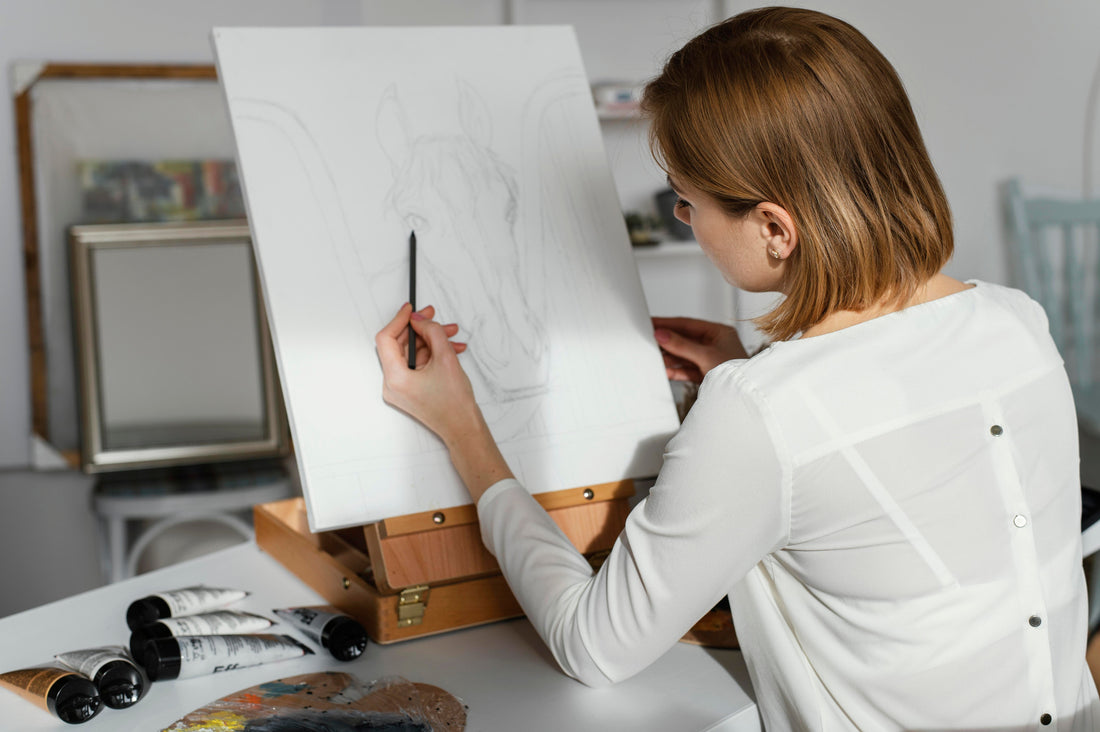
How to choose the right materials for drawing?
Whether you're an experienced artist or a passionate beginner, choosing the right drawing materials is essential to fully expressing your creativity. The choice of art supplies not only influences the quality of your artwork, but also your enjoyment and efficiency during the creative process. In this article, we'll explore the key elements to consider when selecting the ideal materials for your drawing techniques, whether for an art exhibition or simply for fun.
1. Start by identifying your real needs
Not everyone needs a suitcase full of 72 pencils or a set of markers that would make an architect swoon. The secret to making the right choice lies in knowing your artistic desires.
Do you want to draw intuitively in a notebook every day, or prepare for an art exhibition in a gallery? What you expect from your practice will directly influence your choices.
Drawing materials come in a multitude of options: types of pencils, erasers, paper, and media. The classic trap is to think you need everything, right away. In reality, a pencil, good paper, and a little time are all it takes to create something truly unique.
Take the example of the work Creature 3 , a gouache and Indian ink on paper, available on our online art gallery Horizon World Art . Its meticulous rendering would not have been possible without paper adapted to the fluidity of the inks. This work illustrates the relevance of the choice of paper to highlight the finesse of the details.

2. The pencil: the true discreet hero of the pencil case
The pencil is not a trivial tool. Between hard (H) and soft (B) leads, there are many nuances. Hard leads are ideal for light sketches, technical lines, or detailed drawings; soft leads, on the other hand, offer strong contrasts and beautiful intensity.
And if you feel like drawing with a ballpoint pen... we won't judge you (too much). That said, real drawing tools are designed to help you achieve fluid, precise, and reproducible movements. The pen, on the other hand, is often the friend of meeting scribbles, not masterpieces.
A good graphite pencil and a quality eraser can be enough to create expressive landscapes, lively portraits or very detailed composition studies.
3. Each technique has its own equipment
Moving from idea to line requires a certain compatibility between your gestures and your instruments. It's not enough to choose randomly: drawing techniques sometimes require specific supplies.
For example, charcoal requires textured paper that holds its material, while alcohol markers prefer smooth, absorbent surfaces. Quill pens, on the other hand, require a surface that won't bleed through, unless you're into uncontrolled artistic stains.
This is where choosing the right art supplies really comes into its own. A good brush, quality ink, and a notebook suited to your mediums: these often-overlooked elements play a vital role in the quality of the result.
This is demonstrated by the work The Louvre seen from the Tuileries , also visible in our online art gallery . The line, subtle and clear, finds all its strength in the harmonious combination of technique, tool and support.

4. Don't underestimate the importance of comfort
We often think of the pencil, but rarely of the chair. Yet, drawing in poor conditions is like trying to run a marathon in flip-flops: it can be done, but we don't recommend it.
A good workspace, suitable lighting, comfortable seating, a stable work surface - all these are also part of drawing equipment . These elements, although peripheral, directly influence your posture, your concentration and the quality of your drawing.
And let's be honest: a tidy table, with your art supplies within easy reach, makes you want to get back to it.
5. Less is sometimes more
The common misconception that you need an army of markers, brushes, and paper to produce anything worthwhile is a persistent one. But the truth is, a small but well-chosen kit is worth more than drawers full of unused materials.
Investing in a few reliable, durable items that you learn to master will give you much more freedom. You'll then be able to explore and test new textures and effects with full knowledge of the facts.
And if you're unsure, you can always draw inspiration from the artists exhibited at Horizon World Art . Their mastery is often built on a few good, carefully chosen tools and a lot of consistency.
At Horizon World Art , we believe that every artist , whether amateur or experienced, deserves to work with the right tools. That's why, through our online art gallery , we showcase not only finished works , but also the processes that made them possible. So, rather than filling your drawers with gadgets, start by asking yourself: what do I really need to bring my ideas to life? The answer, often, lies in a few well-chosen traits.
